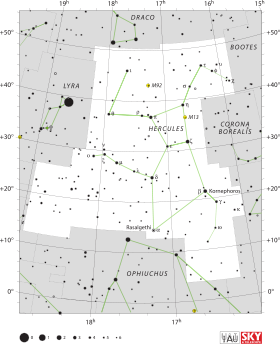Gamma Herculis
γ Herculis
| Ascension droite | 16h 21m 55,214s[1] |
|---|---|
| Déclinaison | +19° 09′ 11,26″[1] |
| Constellation | Hercule |
| Magnitude apparente | 3,76[2] |
Localisation dans la constellation : Hercule | |
| Type spectral | A9IIIbn[3] |
|---|---|
| Indice U-B | +0,19[2] |
| Indice B-V | +0,27[2] |
| Variabilité | SRd présumée[4] |
| Vitesse radiale | −35,3 ± 2 km/s[5] |
|---|---|
| Mouvement propre |
μα = −47,39 mas/a[1] μδ = +43,81 mas/a[1] |
| Parallaxe | 16,93 ± 0,22 mas[1] |
| Distance |
193 ± 3 al (59,1 ± 0,8 pc) |
| Magnitude absolue | −0,12[6] |
| Masse | 2,6 M☉ |
|---|---|
| Rayon | 6 R☉ |
| Luminosité | 92 L☉[6] |
| Température | 7 050 K |
| Métallicité | [Fe/H] = +0,07[6] |
| Rotation | 135 km/s[7] |
Désignations
Gamma Herculis (γ Herculis / γ Her) est une étoile binaire[9] de la constellation d'Hercule. de Sa magnitude apparente combine est de 3,76[2]. D'après la mesure de sa parallaxe annuelle par le satellite Hipparcos, le système est situé à environ 193 années-lumière de la Terre. Son étoile primaire est une géante blanche de type spectral A9IIIbn[3]. C'est une binaire spectroscopique présumée, avec un compagnon qui orbiterait avec une période de 166 jours[9].
Références[modifier | modifier le code]
- (en) F. van Leeuwen, « Validation of the new Hipparcos reduction », Astronomy & Astrophysics, vol. 474, no 2, , p. 653–664 (DOI 10.1051/0004-6361:20078357, Bibcode 2007A&A...474..653V, arXiv 0708.1752)
- (en) J. R. Ducati, « Catalogue de données en ligne VizieR : Catalogue of Stellar Photometry in Johnson's 11-color system », CDS/ADC Collection of Electronic Catalogues, 2237, 0, (Bibcode 2002yCat.2237....0D)
- (en) R. O. Gray et R. F. Garrison, « The Late A-Type Stars: Refined MK Classification, Confrontation with Stroemgren Photometry, and the Effects of Rotation », The Astrophysical Journal Supplement, vol. 70, , p. 623 (DOI 10.1086/191349, Bibcode 1989ApJS...70..623G)
- (en) N. N. Samus', E. V. Kazarovets et al., « General Catalogue of Variable Stars: Version GCVS 5.1 », Astronomy Reports, vol. 61, no 1, , p. 80-88 (DOI 10.1134/S1063772917010085, Bibcode 2017ARep...61...80S, lire en ligne, consulté le )
- (en) Ralph Elmer Wilson, General Catalogue of Stellar Radial Velocities, Washington, Carnegie Institution of Washington, (Bibcode 1953QB901.W495.....)
- (en) E. Anderson et Ch. Francis, « XHIP: An extended Hipparcos compilation », Astronomy Letters, vol. 38, no 5, , p. 331 (DOI 10.1134/S1063773712050015, Bibcode 2012AstL...38..331A, arXiv 1108.4971)
- (en) P. L. Bernacca et M. Perinotto, « A catalogue of stellar rotational velocities », Contributi Osservatorio Astronomico di Padova in Asiago, vol. 239, no 1, (Bibcode 1970CoAsi.239....1B)
- (en) * gam Her -- Double or multiple star sur la base de données Simbad du Centre de données astronomiques de Strasbourg.
- (en) P. P. Eggleton et A. A. Tokovinin, « A catalogue of multiplicity among bright stellar systems », Monthly Notices of the Royal Astronomical Society, vol. 389, no 2, , p. 869–879 (DOI 10.1111/j.1365-2966.2008.13596.x, Bibcode 2008MNRAS.389..869E, arXiv 0806.2878)
Liens externes[modifier | modifier le code]
- (en) Gamma Herculis sur la base de données Simbad du Centre de données astronomiques de Strasbourg.
- (en) James B. Kaler, « Gamma Herculis », sur Stars
- (en) Bright Star Catalogue, « Gamma Herculis », sur Alcyone

